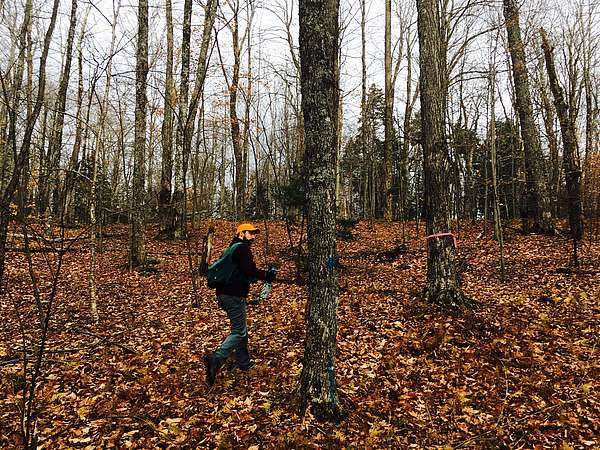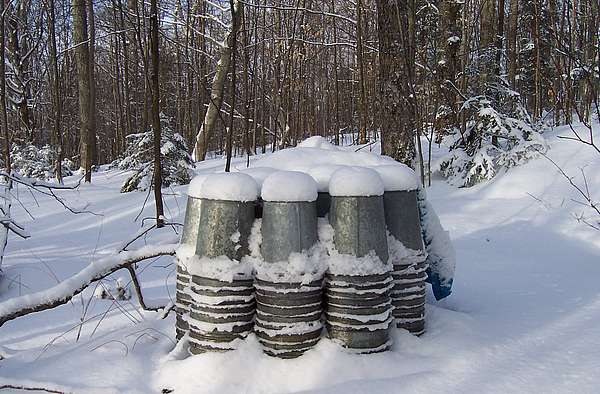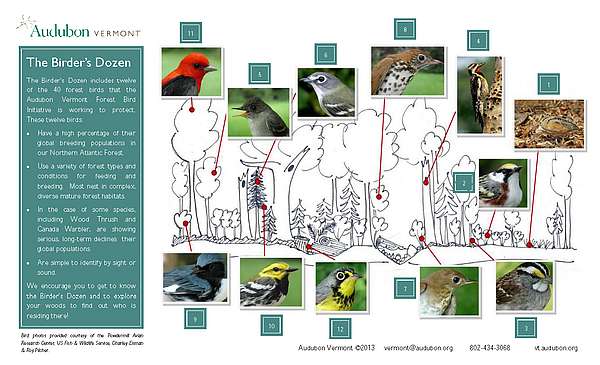Some new signs of activity at Kirchner Woods started appearing at the end of October: colorful flagging and trees spotted with blue paint. The markings are part of a multi-year timber and songbird habitat improvement project that Stowe Land Trust is undertaking on the 75-acre forested property on Taber Hill. Although now best known for its network of public trails, Kirchner Woods has a long history as a working forest that was tended for many years as a sugarbush and woodlot by its previous owner, Jerry Kirchner.
SLT is carrying on the tradition of actively managing the forest for wood products like firewood and timber, but with the added goals of improving habitat quality and demonstrating best forest management practices.
This project has been years in the making. “When we were updating our management plan for Kirchner Woods in 2014, we knew that we wanted to do some active forestry work,” said SLT Conservation Program Manager, Kristen Sharpless. “It took a few years from that point for us to do a forest inventory, put together a specific plan, and hire a consulting forester to administer the project.” The silvicultural treatments that will be applied over the project’s 32 acres are drawn from guides created by Audubon Vermont and the Vermont Department of Forest, Parks & Recreation’s Foresters for the Birds project.
The goal with this project is to combine timber and songbird habitat management, so that we are improving tree heath and vigor while also making conditions more favorable for a suite of Vermont songbirds of conservation concern.
"For example, in one area, we are picking healthy trees to keep and cutting the poorer quality trees that are directly competing with them," explained Sharpless. "Doing so will create small gaps in the forest canopy used by woodland flycatchers like the Eastern Wood-Pewee.”
Although SLT anticipates being able to harvest and sell some of the marked trees for firewood, lumber, or pulp many of the cut trees will be left on site. Felled logs and branches will serve as important perch and drumming site for birds like the Ovenbird and Ruffed Grouse. Downed tree tops will also help protect new seedlings from deer browse, which is heavy in some areas. This type of non-commercial improvement work that doesn’t generate an immediate profit can be eligible for federal incentive funding through the Natural Resources Conservation Service (NRCS).
NRCS is providing a grant to help off-set costs associated with the project at Kirchner Woods, which will enable SLT to get the work done and be creative with finding uses for some of the harvested wood.
All of the mature sugar maples on the property were likely tapped in the past according to SLT’s consulting forester Allan Thompson of Northern Stewards. Most mills won’t take these logs, but there are some that have connections to specialty markets and woodworkers that are looking for the interesting patterns and defects in tapped wood.
“We’d love to find partners interested in working with SLT to create custom pieces like shelves, tables or benches for use in community spaces that feature the maples’ unique character wood," says Sharpless, "as well as opportunities to donate firewood to those in need."
Through this project, SLT has the chance to highlight the many benefits we all get from working forests from local sources of fuel and building materials to wildlife habitat and beautiful spaces for recreation.
Tree marking will continue through the fall. The first trees will be dropped as early as this winter, but most of the cutting will not take place until the later in 2018 or 2019. Work will be done to minimize negative impacts on trails and time that trails need to be closed, as well as to take advantage of opportunities to improve drainage in wet areas. Before then and while the harvest is active, SLT will be providing more opportunities for the public to learn about the details of the project through site walks and information posted on-site and on the SLT webpage.
Questions? Contact Kristen Sharpless at kristen@stowelandtrust.org or (802) 253-7221.



